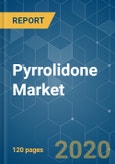The market for pyrrolidone is expected to register a CAGR of about 4% during the forecast period. The major factor driving the market studied is the increasing demand from the chemical processing industry. On the flip side, health hazards caused by N-Methyl-2-Pyrrolidone (NMP) and unfavorable conditions arising due to the COVID-19 outbreak are hindering the growth of the market.
Key Market Trends
Increasing Demand from Chemical Processing Industry Segment
1-Methyl-2-Pyrrolidone, 2-Pyrrolidone, and N-Methyl-2-Pyrrolidone are intensively used in the chemical processing industry, which is anticipated to register a CAGR of about 5%, globally, during the forecast period.
Asia-Pacific to Dominate the Market
Asia-Pacific is expected to be the dominant market in pyrrolidone consumption, as the region dominates the market for the end-user industries, such as chemical processing, electronics, and cosmetics. In countries, like China, Japan, South Korea, and India, the demand for pyrrolidone has been increasing.
Competitive Landscape
The pyrrolidone market is fragmented with the presence of both international and domestic players. The major companies include BASF SE, Ashland, Eastman Chemical Company, Johnson Matthey, and Mitsubishi Chemical Corporation.
Reasons to Purchase this report:
- The development of 2-Pyrrolidone derivatives as pharmaceutical drugs is expected to offer various opportunities for the growth of the market.
- The chemical processing and cosmetics sectors are likely to be the dominant segments, in terms of demand, over the forecast period.
- Asia-Pacific dominates the market across the world, with the largest consumption from countries, such as China, Japan, South Korea, and India.
Key Market Trends
Increasing Demand from Chemical Processing Industry Segment
1-Methyl-2-Pyrrolidone, 2-Pyrrolidone, and N-Methyl-2-Pyrrolidone are intensively used in the chemical processing industry, which is anticipated to register a CAGR of about 5%, globally, during the forecast period.
- Major applications of the pyrrolidone derivates in the chemical processing industry are in extracting agents, reaction solvents, equipment washing, surface coating solvents, de-colorants, and plasticizers.
- Pyrrolidone is heavily used in major unit operations present in refineries and petrochemical plants to extract the various useful chemicals. For example, N-Methyl Pyrrolidone (NMP) is used for the extraction of aromatics from heavier lube distillates for improving the viscosity index. The refining and petrochemicals market is growing at about 4% per year, indicating a stable demand from the sector.
- The chemical processing industry is expected to dominate the pyrrolidone market over the forecast period.
Asia-Pacific to Dominate the Market
Asia-Pacific is expected to be the dominant market in pyrrolidone consumption, as the region dominates the market for the end-user industries, such as chemical processing, electronics, and cosmetics. In countries, like China, Japan, South Korea, and India, the demand for pyrrolidone has been increasing.
- Pyrrolidone is also used as an ingredient in cosmetic formulations. Japan, Singapore, South Korea, Hong Kong, and China are among the top 10 global cosmetics exporters, and the overall Asian cosmetic market is expected to register a CAGR of about 5% during the forecast period.
- N-Methyl-2-Pyrrolidone also finds application as a photoresist stripper, degreasing agent, and coating polyamides in the electronics industry. The Asian electronics market is expected to register a CAGR of more than 5%, with China, Japan, India, and South Korea among the top 10 global electronics manufacturers.
- Thus, the rising demand from the aforementioned end-user industries is expected to drive the growth in the Asia-Pacific region.
Competitive Landscape
The pyrrolidone market is fragmented with the presence of both international and domestic players. The major companies include BASF SE, Ashland, Eastman Chemical Company, Johnson Matthey, and Mitsubishi Chemical Corporation.
Reasons to Purchase this report:
- The market estimate (ME) sheet in Excel format
- 3 months of analyst support
Table of Contents
1 Introduction
4 Market Dynamics
5 Market Segmentation
6 Competitive Landscape
7 Market Opportunities and Future Trends
Companies Mentioned (Partial List)
A selection of companies mentioned in this report includes, but is not limited to:
- Arkema Group
- Ashland
- BASF SE
- Chemex Organochem Pvt. Ltd
- Covestro AG
- DuPont
- Eastman Chemical Company
- Huntsman Corporation
- INEOS Composites
- Johnson Matthey
- LyondellBasell
- Merck KGaA
- Mitsubishi Chemical Corporation
Methodology

LOADING...








